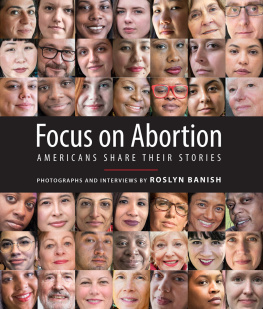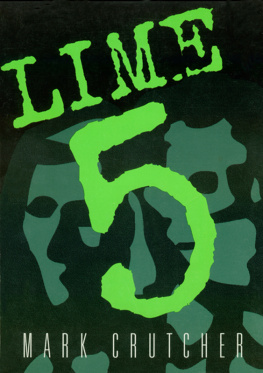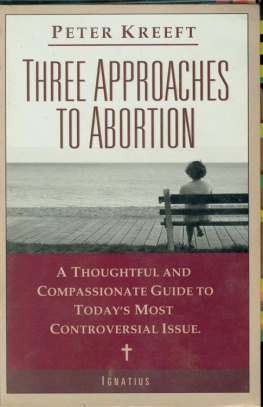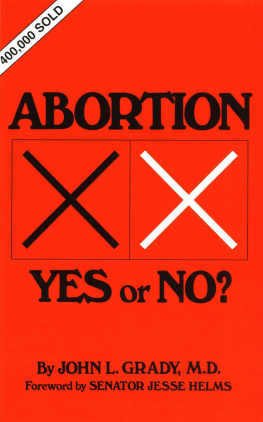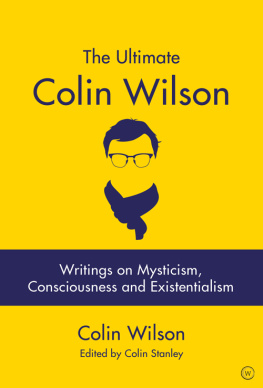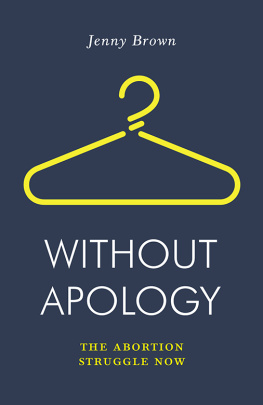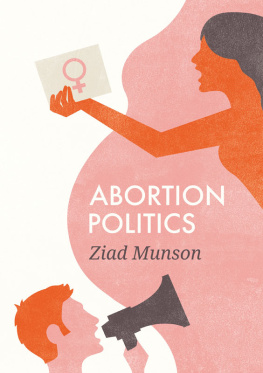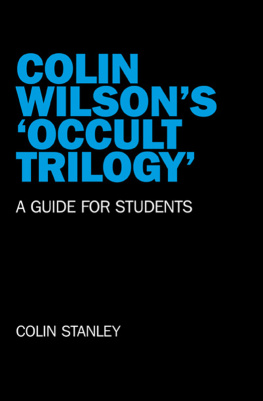ABORTION IN THE USA AND THE UK
Abortion in the USA and the UK
Colin Francome
Middlesex University, UK
First published 2004 by Ashgate Publishing
Published 2016 by Routledge
2 Park Square, Milton Park, Abingdon, Oxon OX14 4RN
711 Third Avenue, New York, NY 10017, USA
Routledge is an imprint of the Taylor & Francis Group, an informa business
Copyright 2004 Colin Francome
Colin Francome has asserted his right under the Copyright, Designs and Patents Act, 1988, to be identified as the author of this work.
All rights reserved. No part of this book may be reprinted or reproduced or utilised in any form or by any electronic, mechanical, or other means, now known or hereafter invented, including photocopying and recording, or in any information storage or retrieval system, without permission in writing from the publishers.
Notice:
Product or corporate names may be trademarks or registered trademarks, and are used only for identification and explanation without intent to infringe.
British Library Cataloguing in Publication Data
Francome, Colin, 1944
Abortion in the USA and the UK
1.Abortion - Great Britain - History 2.Abortion - United
States - History 3.Abortion - Political aspects - Great
Britain 4.Abortion - Political aspects - United States
5.Abortion - Law and legislation - Great Britain 6.Abortion
- Law and legislation - Great Britain
I.Title
363.4'6'0941
Library of Congress Cataloging-in-Publication Data
Francome, Colin.
Abortion in the USA and the UK/Colin Francome.
p. cm.
Includes bibliographical references and index.
ISBN 0-7546-3015-3
1. Abortion--United States. 2. Abortion--Great Britain. I. Title.
HQ767.5.U5F71795 2003
363.46'0941--dc22
2003062725
ISBN 9780754630159 (hbk)
ISBN 9781138257535 (pbk)
Frances Kissling
The Culture War Continues
It was 1970 and abortion had just become legal in New York State. I was asked to serve as the director of one of the first clinics providing legal abortion services in the state, and accepted. Thus began a career that has spanned almost a generation; involved both the medical and moral aspects of the issue and taken me around the globe as an advocate for legal abortion. During that time abortion has been a hotly contested public policy issue and one that probably has aroused more passion than any other social and cultural issue of our times. Advocates for and against agree on almost nothing, from the complex question of the moral status of the fetus to the simple question of whether or not abortion is medically safe for women.
The public debate has become highly predictable. Whether one is in New York, London, Mexico City, Lagos or the United Nations, the discourse is the same. The television viewer knows exactly what the prochoice spokesperson will say and is fully prepared for the claims of the opponent of legal abortion. As a result, most of us have stopped listening. As we look to the future of legal abortion, listening becomes imperative. In this book, Colin Francome guides us through 50 years of history in the effort to legalize abortion in the United States and the UK. Each country's route to legal abortion has been different and these differences are thoroughly detailed and analysed herein. Understanding these differences may be key to understanding the continued controversy that surrounds current attempts to decriminalize abortion in much of the developing world and to preserve legal abortion in a number of countries where it is challenged by conservatives.
The liberalization of abortion laws did not happen in a vacuum. Francome notes that major reforms to abortion laws began in 1967 and ended in 1982. This should come as no surprise. The 1960s and 1970s in the US and Europe were decades of major social change and economic prosperity. The birth control pill was introduced; civil rights for racial minorities were increasingly recognized; women's rights advanced dramatically and the sexual revolution was in full swing. The backlash began in the 1980s. The economy slowed; Thatcher, Reagan and Khomeini rose in power. Religious fundamentalism in the US and the Middle East came into full bloom. The culture war raged. It is in this context that country by country progress in changing abortion laws and saving women's life came to a near stand still.
The tragedy of this stand still is that those women most in need of legal abortion services are still without them. In the developing world where women's lives are crippled by poverty and patriarchy, it is estimated that more than 60,000 women a year die as a result of botched abortions, most illegal. Countless more suffer physical and psychological complications from botched abortions. These women are the visible proof of the fact that today, as fifty years ago, women who need abortions will risk everything including their lives to end pregnancies they consider unsupportable. They do so not because they are selfish, as the opponents of abortion tell us, but because they understand that bringing new life in to the world is the most important responsibility and right a woman possesses. Throughout history women have proven that they can be trusted to decide when it is appropriate to exercise their right to bring that life into the world. Isn't it time to end the culture wars and recognize that right?
Chapter 1
Introduction
On 4 June 2003 Congress outlawed a form of later abortion often used with handicapped fetuses or where the woman was ill. It was the most significant restriction in the 30 years since abortion was legalized in the case of Roe v . Wade. The change led a commentator to state 'Always more conservative about abortion than Britain, America is now in the mood to reverse abortion rights as never before' (Goldenberg 2003). This book considers the differences in the situation on either side of the Atlantic. In the final chapter, it makes a case for the pro choice position. The two chapters on the period when abortion was illegal show that, despite the risks to health and the costliness of illegal operations, they were nevertheless prevalent. This suggests that abortion cannot be legislated out of existence; rather, there are great limits in what legislators can do to prevent it unless they choose the path of education and openness. If this occurs, the better knowledge of contraception is likely to reduce the number of unplanned and unwanted pregnancies. Also in the final chapter, some consideration is given to another aspect of the right to chose. This is that many couples or individual women find that it is very difficult to have the children they want. The percentage of women remaining childless throughout their lives has increased. For some, this will be a conscious choice. However, many are denied maternity by the demands of society; so supporting the right of choice must also include the right of maternity, if this is what is desired.
1.1 The Wider Effects of British Law
As I explained in my previous book Abortion Freedom, the British Act of 1967 helped to spark a worldwide trend to relax the laws. In the period until 1982, more than forty countries extended their grounds and only three narrowed them. This change meant that nearly two-thirds of women lived in countries where laws permitted abortion on request or on a wide variety of grounds. Fewer than one in ten lived in countries where abortion was totally prohibited (Francome 1984). The United States was one of the countries to change its laws radically, and the Supreme Court decision of 22 January 1973 led to the individual states having to change their laws. The laws on abortion deal with a variety of issues such as where the operations should be performed, who should perform them, whose consent is required in the case of minors, what time limits should be adhered to and what conscience clauses should be followed. The laws even between countries with liberal legislation vary a great deal on these matters. There are also wide variations as to the method of payment. In some countries abortions are paid for on the National Health Scheme; in Britain the chances of a free abortion depend to some degree on where the woman lives and the attitudes of her doctor, whereas in the United States free abortion is largely conditional on being a Medicaid patient and living in a state which finances the operations.




